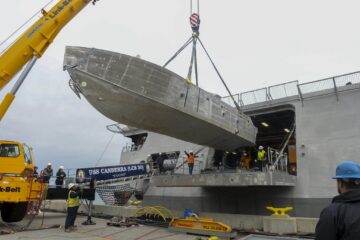DRATRI is a specialized research institute that was established following the reorganization of the Defense Industry Technology Support Center, an affiliate of South Korea’s Agency for Defense Development (ADD). DRATRI is primarily responsible for the ‘Rapid Acquisition’ task, one of the key components of the ‘Defense Innovation 4.0’ initiative promoted by the Yoon Suk-yeol administration. ‘Rapid Acquisition’ refers to the process of simplifying procedures to acquire advanced defense technology and weapons, not only shortening the time required but also rapidly introducing cutting-edge technology into the defense industry through collaboration with private companies.
After two years of research and development followed by six months of military demonstration operation, Hanwha Systems will develop and supply the Republic of Korea (ROK) Navy with an ‘automatic mine detection system for vessels’ and an ‘automatic mine detection system for land-based training’. Applying the latest Artificial Intelligence (AI) technology, the ROK Navy’s automatic mine detection system will be capable of quickly and accurately detecting and neutralizing mines. This is achieved by establishing a big data infrastructure of naval mine and seabed environmental information and utilizing deep learning.
The modern challenge of detecting naval mines is indeed significant, especially considering the complex marine environments and the mines’ ability to remain concealed on the seabed. This poses a substantial threat to naval vessels and merchant ships alike. The ROK Navy is actively addressing this issue through its fleet of specialized vessels and advanced technology. Currently, the Navy operates the Ganggyeong-class Mine Hunter Crafts (MHC) and Yangyang-class Mine Sweeper Hunter (MSH). These vessels play a crucial role in ensuring maritime safety by detecting and neutralizing naval mines. However, to further enhance their capabilities and address the evolving challenges in mine countermeasures, the ROK Navy is planning to implement the Mine Sweeper Hunter II (MSH-II) project. This project will replace the old Ganggyeong-class MHC’s and supplement the current Yangyang-class MSH.

The new AI-based automatic naval mine detection system is poised to significantly enhance the operations of Mine Countermeasures (MCM) vessels. This system leverages Unmanned Underwater Vehicles (UUVs) and towed array sonars from MCM vessels to continuously search for and collect data on underwater environments and naval mines. By amassing this data, the AI system can implement deep learning techniques, becoming increasingly effective as it accumulates more operational experience.
Jang Hee-sun, Director of the Rapid Demonstration Acquisition Project at DRATRI stated:
“Through the rapid demonstration project, Fourth Industrial Revolution’s advanced technologies from the civilian sector will be quickly introduced to the navy, accelerating the construction of ROK Navy’s future core power, such as unmanned surface vehicles, marine drones, and unmanned underwater vehicles.”
Park Do-hyun Head of Command-and-Control project at Hanwha Systems also stated:
“successful development will contribute to the enhancement of the naval mine countermeasures force and combat readiness.
Hanwha Systems will continue to develop core technologies related to unmanned and autonomous marine systems, securing technological superiority and price competitiveness to explore export markets.”
AI System for Mine Warfare – existing example
Thales of France previously introduced MiMap. It is a mission analysis tool, which allows operators to analyze sonar data either in real-time or recorded during a mission. Using AI, MiMap helps operators to efficiently investigate the seabed, classify and localize contacts and report changes from the last known state of an area.






